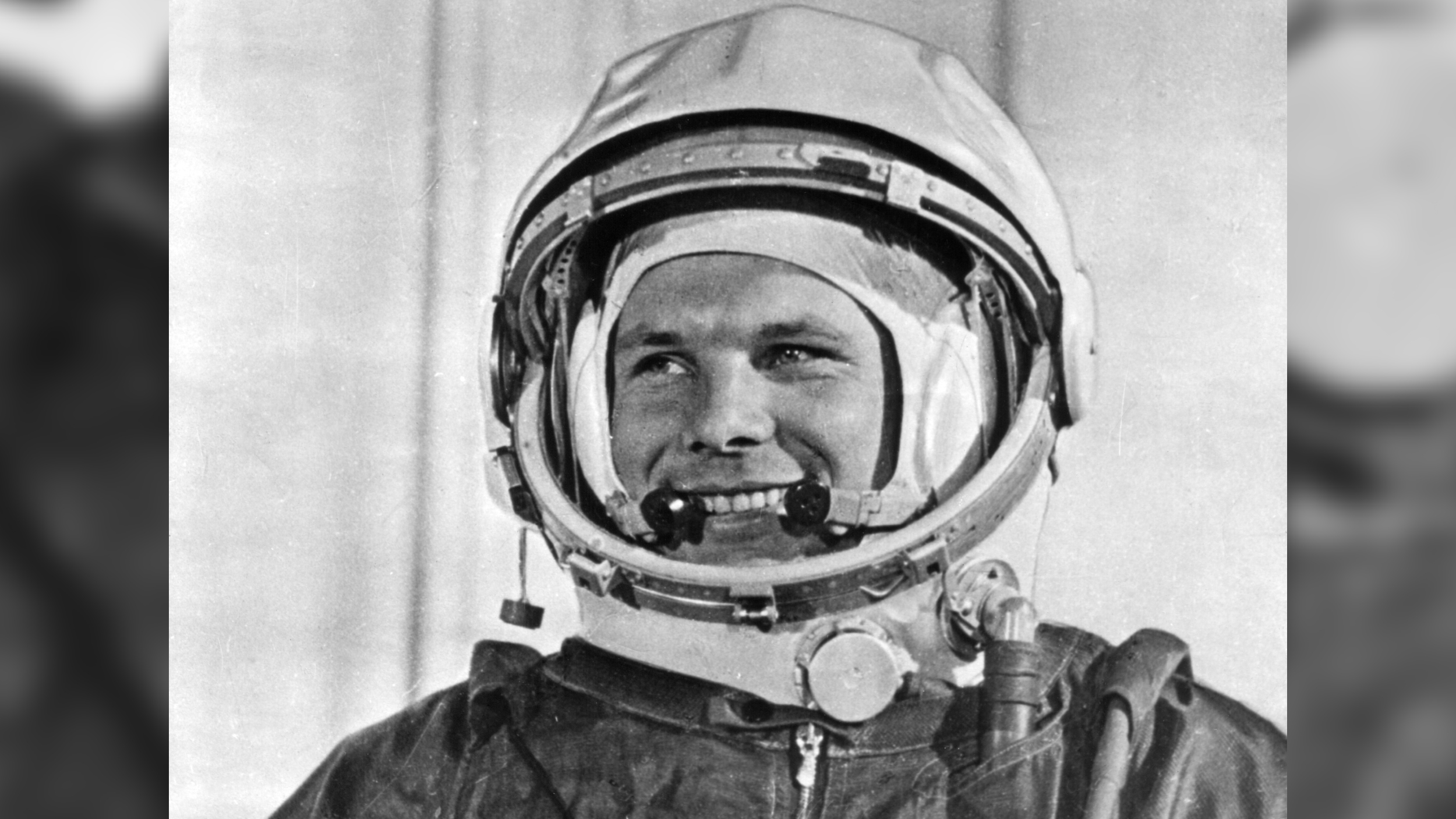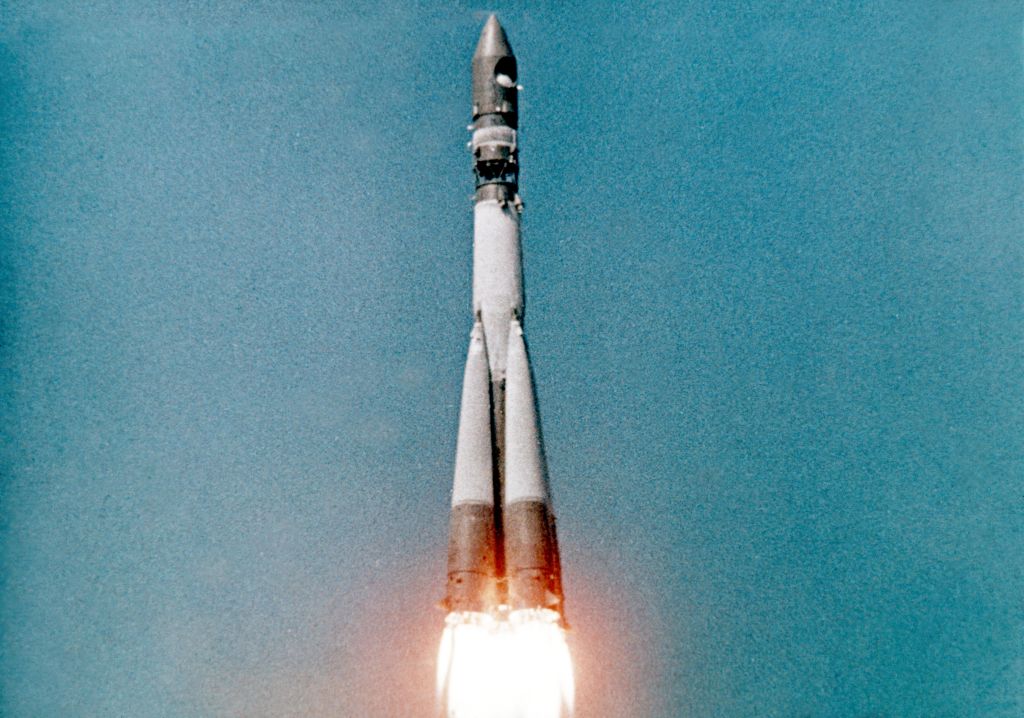Yuri Gagarin: Facts about the first human in space
Yuri Gagarin was the first human in space when he orbited Earth in 1961 aboard the Vostok 1 space capsule.

Yuri Alekseyevich Gagarin was a Soviet pilot and cosmonaut who became the first human in space. In 1961, he orbited Earth aboard the Vostok 1 space capsule, the first-ever crewed spacecraft. As a result, he became an international celebrity and received many awards for this achievement, both within and outside the Soviet Union.
Vostok 1 was Gagarin's only spaceflight. He was on the backup crew for the Soyuz 1 mission but wasn’t allowed to go to space after that mission ended in a fatal crash because officials worried that Gagarin, a national hero, would be killed. Though he was eventually allowed to continue flying regular aircraft, he died five weeks after being cleared to fly again, when his flight-training airplane crashed. The exact cause of the crash is still unknown.
Related: Yuri Gagarin on Vostok 1: How the 1st human spaceflight worked (infographic)
Yuri Gagarin FAQs
Who was the first man in space?
Yuri Gagarin, a Soviet pilot and cosmonaut, was the first person in space and the first to orbit Earth.
How old was Yuri Gagarin when he died?
Yuri Gagarin was 34 when he died.
How many times did Yuri Gagarin go to space?
Gagarin went to space only once, aboard the Vostok 1 capsule. He was also the backup crewmember for the Soyuz 1 mission.
Childhood and cosmonaut selection
Gagarin was born on March 9, 1934, in the Soviet Russian village of Klushino to parents who worked on a collective farm, according to the European Space Agency (ESA). Beginning in October 1941, German soldiers occupied Klushino as part of their advance on Moscow during World War II. The occupation lasted 21 months, according to the BBC. In 1946, his family moved to the nearby town of Gzhatsk (now named Gagarin), where he went to secondary school and studied math and physics, according to the New Mexico Museum of Space History.
After six years of secondary school, Gagarin went to technical school in Saratov, where he also joined a local flying club and began learning to fly a plane. He went on to attend the Soviet Air Force Academy and graduated in 1957. He was one of 20 Soviet fighter pilots chosen as cosmonauts, in part because of his small size, according to ESA. To fit in the small Vostok capsule, cosmonauts couldn't be taller than 1.75 meters (5 feet 9 inches), according to Star Walk, and Gagarin was 1.57 m tall (5 feet 5 inches), according to ESA. In fact, in a 1961 interview, Gagarin described the capsule as quite roomy, especially compared with airplane cockpits of the time.
Alongside other cosmonauts, Gagarin participated in intensive preparation for spaceflight, including various physical and psychological experiments. A doctor doing psychological testing on him praised his "high degree of intellectual development," noting his attention to detail, strong imagination, quick reaction time and skill in doing mathematical calculations, according to ESA.
Vostok 1 mission
"Vostok" means "East" in Russian, as opposed to the Western world, signifying the mission's importance in the Cold War-era space race between the United States and the Soviet Union. The crewed part of the capsule was spherical, with an inside diameter of about 7 feet (2 m), according to The Planetary Society. The spacecraft launched on April 12, 1961, from the Baikonur Cosmodrome in what is now Kazakhstan.
Breaking space news, the latest updates on rocket launches, skywatching events and more!
In response to a statement from ground control that everything seemed to be working fine, Gagarin famously replied "Poyekhali!" — an informal phrase meaning "Off we go!" in Russian, according to ESA.
Gagarin orbited Earth in the capsule for about an hour before the spacecraft reentered Earth's atmosphere. For the most part, the flight went smoothly, though Gagarin lost communication with ground control several times. The two parts of the spacecraft also failed to correctly separate for a while during reentry, and the spacecraft shook violently. But when the capsule was about 4 miles (6 kilometers) above the ground, Gagarin parachuted back to Earth as planned, landing on farmland outside the city of Engels, Russia.
After the mission, Gagarin became an overnight international celebrity; the Soviet Union had kept his spaceflight secret until it was successful. Gagarin was known not only for his accomplishments but also for his charismatic personality and smile, according to the BBC. Though he was barred from visiting the United States, he traveled the world and received many honors, The Telegraph reported. This included the title "Hero of the Soviet Union," the nation's highest honor.
Soyuz 1 and death
On April 23, 1967, the Soyuz 1 mission launched with cosmonaut Vladimir Komarov as its sole crewmember, with Gagarin as the backup. During the spacecraft's landing, the parachute failed to deploy, instantly killing Komarov when it hit the ground. Though Gagarin had nothing to do with the crash (and even reportedly tried to get the launch postponed due to safety concerns), the Soviet Union barred him from spaceflight after the crash, out of fear that their national hero would be killed, according to the BBC. Officials also originally also banned him from flying regular aircraft.
After completing additional training, Gagarin was eventually allowed to continue flying. But on March 27, 1968, the plane he was test-piloting crashed, killing him and flying instructor Vladimir Seryogin, according to ESA.
It is unclear exactly what caused the crash. An investigation by the KGB, the former Soviet security and intelligence agency, found that the aircraft went into a spin, possibly maneuvering sharply to avoid a weather balloon. According to the report, the two pilots couldn't regain control; they believed they were at a higher altitude than they actually were because of the inaccurate weather information they'd been given. The report is difficult to confirm, and there are many theories about the crash, including conspiracy theories that Gagarin's death was orchestrated by Soviet officials.
Additional resources
You can learn more about the first man in space with these pieces from Scientific American and Astronomy.com. Space Center Houston's on this day in history details Gagarin's historic flight to space.
Bibliography
BBC News. (2011, April 8). Yuri Gagarin: 'I was never nervous during the space flight.' [video]. https://www.bbc.com/news/av/uk-politics-12983333
Dowling, S. (2021, April 12). Yuri Gagarin: the spaceman who came in from the cold. BBC Future. https://www.bbc.com/future/article/20210409-yuri-gagarin-the-spaceman-who-came-in-from-the-cold
European Space Agency. (2007, February 4). Yuri Gagarin. www.esa.int/About_Us/ESA_history/50_years_of_humans_in_space/Yuri_Gagarin
European Space Agency. (2007, February 4). The flight of Vostok 1. https://www.esa.int/About_Us/ESA_history/50_years_of_humans_in_space/The_flight_of_Vostok_1
Lapenkova, M. (2018, March 27). Fifty years on, Yuri Gagarin's death still shrouded in mystery. Phys.org. http://www.phys.org/news/2018-03-fifty-years-yuri-gagarin-death.html
McKeever, A. (2022, April 12). How the space race launched an era of exploration beyond Earth. National Geographic. https://www.nationalgeographic.com/science/article/space-race-early-human-spaceflight-history-missions?loggedin=true&rnd=1699322304385.
Orange, R. (2011, April 12). Yuri Gagarin: 50th anniversary of the first man in space. The Telegraph. http://www.telegraph.co.uk/news/science/8443777/Yuri-Gagarin-50th-anniversary-of-the-first-man-in-space.html
Star Walk. (2021, April 11). 60th anniversary of the first human space flight. https://starwalk.space/en/news/60th-anniversary-of-the-first-human-space-flight
Swopes, Brian. “Pilot-Cosmonaut Yuri Alexseyevich Gagarin, Hero of the Soviet Union.” This Day in Aviation. 14 Apr. 2023, https://www.thisdayinaviation.com/tag/yuri-alekseyevich-gagarin/. Accessed November 7, Nov. 2023.
The Planetary Society. (n.d.). Yuri Gagarin and Vostok 1, the first human spaceflight. Retrieved November 7, 2023, from https://www.planetary.org/space-missions/vostok-1

Rebecca Sohn is a freelance science writer. She writes about a variety of science, health and environmental topics, and is particularly interested in how science impacts people's lives. She has been an intern at CalMatters and STAT, as well as a science fellow at Mashable. Rebecca, a native of the Boston area, studied English literature and minored in music at Skidmore College in Upstate New York and later studied science journalism at New York University.

